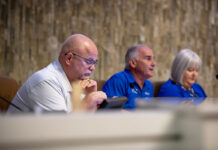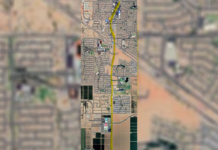
Will Maricopa continue as a bedroom community where children attend school and play Little League while their parents commute to work each morning? Or will it become an independent economic center, a bright spot in the developing Sun Corridor?
The city’s vision
Micah Miranda, economic development director for the city, said the goal is for Maricopa to transition from a bedroom community to an independent municipality, with its own economic center of industry.
“Right now we serve as a bedroom community, but as we mature through our municipal life cycle, we will begin to develop an industrial office and commercial base that people won’t have to leave Maricopa for,” Miranda said.
The key to any transition is the ability to bring in outside dollars, said Lee McPheters, director of the JPMorgan Chase Economic Outlook Center at Arizona State University’s W. P. Carey School of Business.
“You’ve got to have some industries that sell goods or bring services outside the area,” McPheters said. “If you’re going to be a stand-alone area, you’ve just got to have that.”
Retail businesses, while beneficial for residents and the city’s internal economy, do not spur bedroom communities into economic centers because “retail recirculates existing dollars,” McPheters said.
“There’s no reason to come to Maricopa to go to Walmart,” he pointed out.
Industries traditionally aiding transition are health care, agriculture, wholesale and manufacturing.
Miranda said the city’s efforts are on “four areas that we focus on: health care, agri tech, clean tech, professional and technical services.”
Those areas specifically leverage readily available assets, including a young, highly educated workforce and a business-friendly city.
“We’re not trying to be biotech, we’re not trying to be aerospace aviation, we have our industry sectors, which we actively pursue,” Miranda said.
For health care, Miranda pointed to the recently completed Banner Health Center.
Also, Dignity Health plans to build a 34,800-square-foot, two-story hospital on 18.56 acres of land it purchased in September on State Route 347 and Smith-Enke Road.
Construction is expected to begin by 2016, after an urgent care is built next year.
For education, Miranda said the new Central Arizona College campus will provide a local workforce for prospective industries.
When it comes to professional and technical services, Miranda said the 70-acre Estrella Gin development at Acacia Crossings could be a diverse business park.
The economic development director said the city aggressively pursues prospective business leads.
“We spend a lot of time developing relationships, cultivating relationships, getting people down here to see what the real Maricopa is,” Miranda said.
Challenges to the vision
For all of the city’s efforts, Maricopa is confronted with larger economic challenges it has little to no control over.
First, the Sun Corridor — the area from Prescott to Tucson — is “one of the significant population growths in the future,” but a double-edged sword for Maricopa, McPheters, of the W.P. Carey School, said.
On one hand, should Interstate 11 become a reality and the city have export industries in place, Maricopa would be well positioned to thrive because, McPheters said, transportation is key to transitioning to independence.
Normally, an aspiring metropolis would need “air or rail to transport those goods and services,” but an interstate could help, he said.
Longtime Maricopan Eddie Rodriguez agreed transporation is vital to the city’s independence.
“We’re going to be a bedroom community until an alternative route is made from Phoenix to Maricopa,” Rodriguez said.
He said commercial interests “see (State Route) 347 as a liability” because flooding and accidents mean “those road closures can happen at any time.”
However, most recent estimates don’t see the interstate coming into fruition for up to 30 years.
The city’s population growth could also serve to further lock Maricopa in as a bedroom community.
“The bedroom communities always see that population growth and so they function that way for quite some time,” McPheters said. “They just continue to be a bedroom community because that’s the way the growth has evolved.”


![Carl’s Jr plans to “open soon” An exterior view of the new Carl's Jr. restaurant along John Wayne Parkway on May 7, 2024. [Elias Weiss]](https://www.inmaricopa.com/wp-content/uploads/2024/05/E1C66482-CB4C-4FD0-BA30-35CECE93F4BE-218x150.jpeg)
![Filiberto’s eyes building Maricopa restaurant An exterior view of a Filiberto's Mexican Food restaurant at an unknown location and date. [Jessica Boehm/Axios]](https://www.inmaricopa.com/wp-content/uploads/2024/05/axios-050724-filibertos-screenshot-e1715117410101-218x150.jpg)
![SR 238 closures start tomorrow SR 238 [File]](https://www.inmaricopa.com/wp-content/uploads/2022/04/az-238_e_seq_034-218x150.jpg)




![In mayoral race, it’s the Nancy Smith show Maricopa Chamber of Commerce Executive Director Kelly Anderson grills incumbent Mayor Nancy Smith in election's first campaign event April 30, 2024, at Southern Dunes Golf Club. [Elias Weiss]](https://www.inmaricopa.com/wp-content/uploads/2024/04/CRM_1009-218x150.jpg)




![Carl’s Jr plans to “open soon” An exterior view of the new Carl's Jr. restaurant along John Wayne Parkway on May 7, 2024. [Elias Weiss]](https://www.inmaricopa.com/wp-content/uploads/2024/05/E1C66482-CB4C-4FD0-BA30-35CECE93F4BE-100x70.jpeg)

![Filiberto’s eyes building Maricopa restaurant An exterior view of a Filiberto's Mexican Food restaurant at an unknown location and date. [Jessica Boehm/Axios]](https://www.inmaricopa.com/wp-content/uploads/2024/05/axios-050724-filibertos-screenshot-e1715117410101-100x70.jpg)